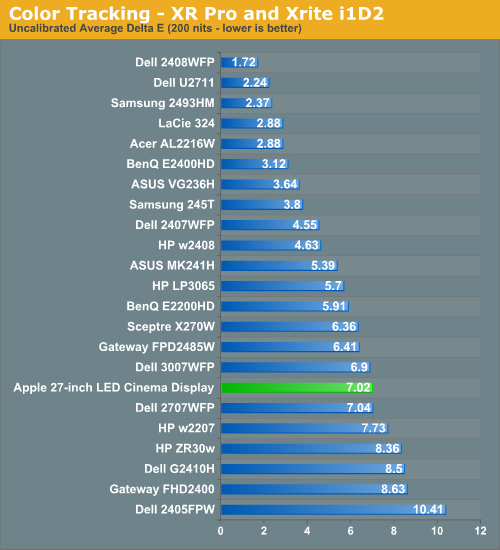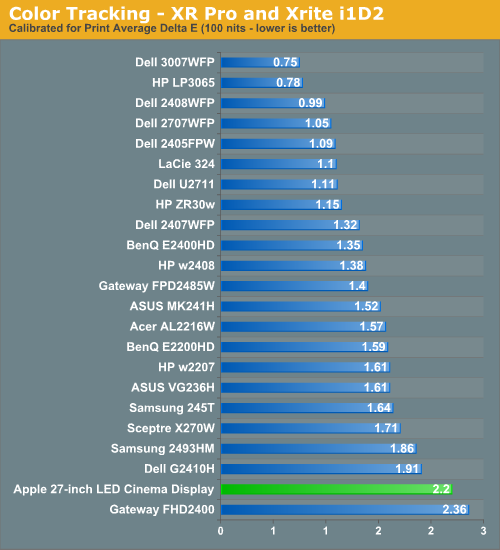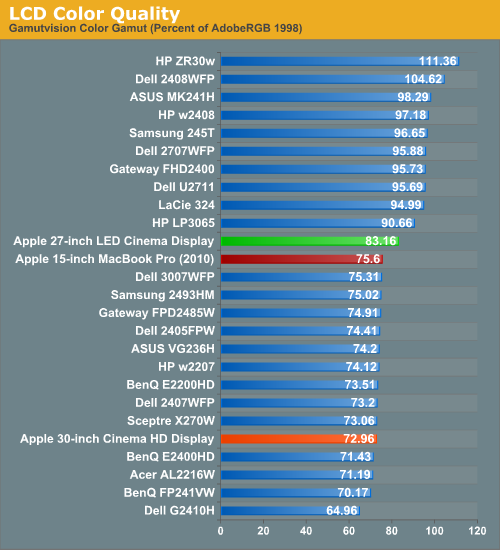Apple 27-inch LED Cinema Display Review
by Anand Lal Shimpi on September 28, 2010 12:15 AM EST- Posted in
- Displays
- Mac
- Apple
- Cinema Display
Color Quality
We report two main quality metrics in our display reviews: color accuracy (Delta-E) and color gamut. Color gamut refers to the range of colors the display is able to represent with respect to some color space. In this case, our reference is the AdobeRGB 1998 color space, which is larger than the sRGB color space. So our percentages are reported with respect to this number, and larger is generally better.
Color accuracy (Delta E) refers to the display’s ability to display the correct color requested by the GPU and OS. The difference between the color represented by the display, and the color requested by the GPU is our Delta-E, and lower is better here. In practice, a Delta E under 1.0 is perfect - the chromatic sensitivity of the human eye is not great enough to distinguish a difference. Moving up, a Delta E of 2.0 or less is generally considered fit for use in a professional imaging environment - it isn’t perfect, but it’s hard to gauge the difference. Finally, Delta E of 4.0 and above is considered visible with the human eye. Of course, the big consideration here is frame of reference; unless you have another monitor or some print samples (color checker card) to compare your display with, you probably won’t notice. That is, until you print or view media on another monitor. Then the difference will no doubt be apparent.
As I mentioned in our earlier reviews, we’ve updated our display test bench. We’ve deprecated the Monaco Optix XR Pro colorimeter in favor of an Xrite i1D2 since there are no longer up-to-date drivers for modern platforms.
For these tests, we calibrate the display and try to obtain the best Delta-E we can get at both 200 nits of brightness for normal use, and 100 nits for print brightness. We target 6500K and a gamma of 2.2, but sometimes the best performance lies at native temperature and another gamma, so we try to find what the absolute best performance could be. We also take an uncalibrated measurement to show performance out of the box using either the manufacturer supplied color profile, or a generic one with no LUT data. For all of these, dynamic contrast is disabled.


Uncalibrated the display's color accuracy isn't very good. I found the 27-inch LED Cinema Display to be way too blue and green out of the box, calibrated the display did much better:


The 27-inch LED Cinema Display isn't going to be winning any awards for color reproduction but it's good enough when calibrated.


Curiously enough, dropping brightness down to 100 nits caused a noticeable reduction in color tracking. The average delta E went up to 2.2 while most of the 27's competitors remained about the same. The 27-inch behaves very differently depending on what brightness setting you have it on.

Apple managed to do relatively well with the WLED backlight but it's still no match for the color gamut you get from any of the CCFL backlit displays. Note that my old 30 hasn't aged well, it's only able to cover roughly 73% today.











93 Comments
View All Comments
kukuuu - Tuesday, January 25, 2011 - link
Ive heard that windows doesnt work and thus there might not be gaming from my pc. Also the minidisplay issue means ,im not sure about it at al :(bcron - Tuesday, April 19, 2011 - link
Hello,First of all: thanks for your test – it is by far the best I could find!
I have the first version of the 30" Cinema Display and would like to buy a new display. I am using my 30" primarily for image and video processing, and photo printing (with an Epson Stylus Photo R3000).
My question is: Do you think that the 27" is better, worse or equal to the 30" (first version) for photography and image processing? (I am not talking about the glare/nonglare-discussion but only about colour accuracy for image editing and photo printing)
From what I´ve seen from your test the 27" seems to have a better colour space: 83.16% vs 72.96% for the 30". (By the way, is there a way to measure the actual color space of my display? I have a DTP94 colorimeter and use iColorDisplay and basiCColor, but I could not find an option to measure the colour space in percentage of Adobe RGB)
At a setting of 100cd/m2 (for photo printing) the 27" has a deltaE of 2.2. But in this diagram there is no comparable value of the 30" display.
Is 2.2 good enough for professional photo printing? I do know that there are better displays but what I do not know is: how big is the difference, eg. compared to a deltaE of 1.1 really – in terms of human perception?
Thanks!
B.C.
dffs - Thursday, December 11, 2014 - link
There are several things wrong with this monitor. First, of course, the price. Other monitors, such as the Dell UltraSharp 27, appear to use the same screen, and have a street price of nearly half of this one. Although the aluminum case is lovely, it seems impossible to justify the price differential. Second, its height is not adjustable. This is a serious drawback if, for example, you want to use it as an external monitor with an iMac. Third, a good monitor needs its own color controls, featuring RGB sliders. The only way to adjust colors on a Mac monitor is by that exceedingly lame Colors section of the Displays control panel. It's high time Apple gives us something better.